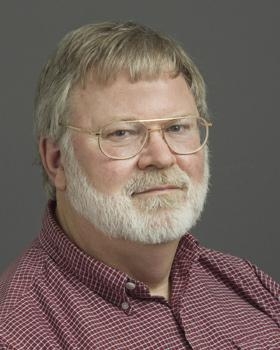UC Blogs
Fly Parasite in Honey Bee? A New Threat?
The news that flashed across the Internet today indicates there's a new threat to honey bees, a parasitic phorid fly. UC San Francisco researchers,...
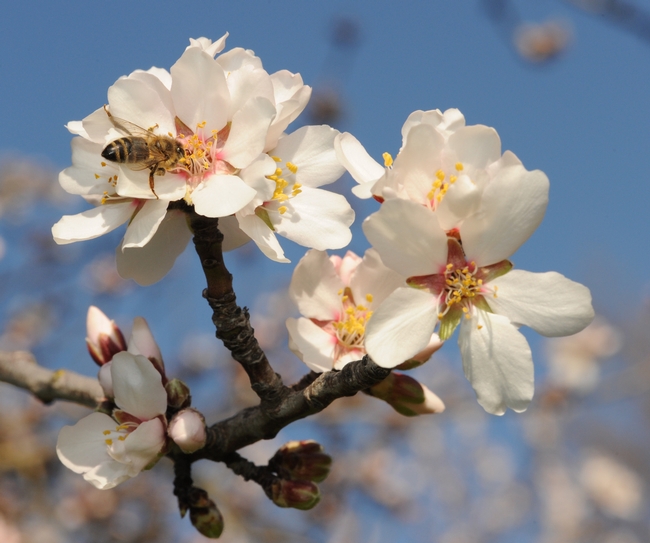
Honey bee pollinating an almond blossom in the spring of 2011. (Photo by Kathy Keatley Garvey)
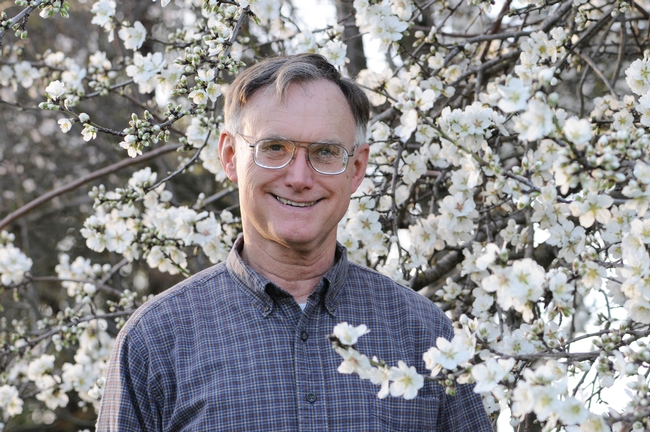
Noted honey bee expert, Extension apiculturist Eric Mussen of UC Davis, by an almond tree at the Harry H. Laidlaw Jr. Honey Bee Research Facility at UC Davis. (Photo by Kathy Keatley Garvey)
ANR in the news during winter break
While many offices are closed between Christmas and New Year's Day, the media don't stop distributing news. Following is a sampling of recent news stories with an ANR connection.
In battle to save Bonny Doon vineyards, scientists try tricking bacteria
Beth Mole, Santa Cruz Sentinel
But to stop these microscopic killers, scientists had to do some criminal profiling.
When Xylella get into a grape vine, they're released in the vascular tissue -- the plumbing of the plant that pumps water up from the roots. From there, the bacteria use the tissue as "hallways" to invade the whole vine. They then start exploring and munching on the plant.
"We think that the exploratory phase involves rather promiscuous movement of bacteria," Lindow said. But as they spread from place to place, there are only a few bacteria in each area, he said.
Each bacterium constantly sends out a molecular beacon that allows them to collect. Lindow and his team of researchers realized that this beacon is the bacteria's glaring weakness -- without it, they wouldn't make it into their next sharpshooter or kill the vine. So, the researchers engineered transgenic grapevines to make the same beacon.
Pesticide use rises throughout Merced County
Joshua Emerson Smith, Merced Sun-Star
Pesticide use in Merced County is on the rise, according to the annual report from the California Department of Pesticide Regulation. The bump followed a statewide trend that saw an increase in pesticide use after four years of decline.
The reporter talked to Paul Towers, a spokesperson for the Pesticide Action Network, who said, "California is stuck on a pesticide treadmill."
UC Cooperative Extension farm advisor Maxwell Norton said the idea that alternatives to pesticides aren't being pursued is false.
"Pest management has more resources dedicated to it than any other field of agriculture research," he said. "Agricultural researchers are putting a lot of resources into alternative systems. The research reports are there in the hundreds for people to read. We will eventually come up with alternatives."
Leaf curl dilemma
Debbie Arrington, The Sacramento Bee
Folks with backyard peach or nectarine trees face a major problem this winter. Used to control leaf curl, Micro-cop copper fungicide spray and lime sulfur no longer are available to California home gardeners due to environmental concerns. The fungicide sprays that are available have much lower concentrations of copper.
"It's a pretty big deal right now," said Chuck Ingels, Sacramento County UC Cooperative Extension's horticulture advisor. "Those products worked. We don't really have an alternative yet."
This month, Ingels and master gardeners are conducting tests on possible alternatives, such as Liqui-Cop and Concern copper soap, at the Fair Oaks Horticulture Center's orchard. Because the fungus needs water to multiply, they're also testing another approach: Covering whole trees with breathable fabric to prevent moisture from accumulating on the branches.
"Until we know what works, the best option is to plant varieties that are resistant to leaf curl," Ingels said.
Olive oil's secret: Not enough real virgins
Ronald Holden, Crosscut.com
In a report a year ago, UC Davis researchers found that 69 percent of imported "extra virgin" olive oil (and 10 percent of domestic oil) wasn't what it pretended to be. Even the best-known brands showed signs of adulteration —blended with inferior grades of olive oil or cheaper oils from soybeans, hazelnuts, and sunflower seeds.
The lone import to receive top ratings on all points was Costco's Organic Extra Virgin Oil, which sells for one-fifth the price of competing brands.
Crazy Winter
Such a peculiar winter, although the calendar says it's winter alot of
color remains in my garden. The Limonium perezii, aka statice or sea
lavender continues to push out new color spikes which will dry
beautifully for indoor arrangements. The various Tropaeolum spp., aka
nasturtiums are blooming wildly. They seed so vigorously I have given
dozens of seeds to many of my neighbors this year. I never tire of
their sunny yellow and orange . A ruby red Chrysanthemum carinatum,
or summer chrysanthemum is re-blooming after a short break during the
fall. My favorite bush rose with an antique apricot bloom continues as
long as I remember to deadhead the spent flowers. A late summer
cosmos started from seed brings cheer to my front seating area. This
Cosmos sulphureous, a yellow dwarf, was sprinkled over the soil in
late July and finally popped it's blooms in October. Additionally the
coreopsis, calendula, canna, and yarrow are still putting on a show.
With so little rain I have continued to hand water about once a week.
The color from my garden has been so welcome during our many overcast
days, but I think it's time for a rest. Best wishes to all.
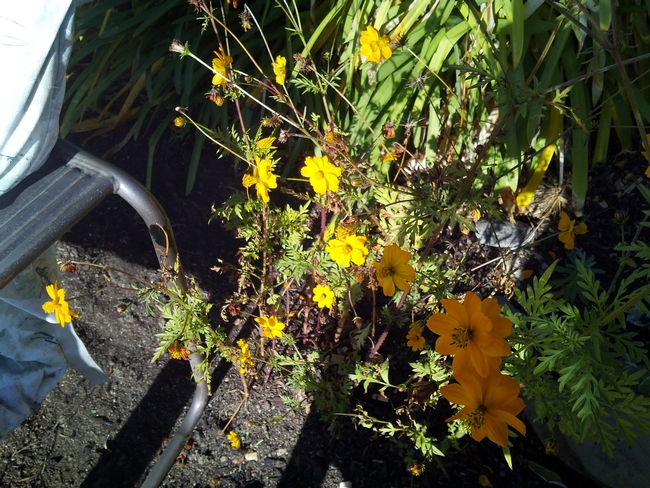
Orange coreopsis. (photo by Trisha Rose)
Might as Well Be Spring?
When California poppies (Eschscholzia californica) bloom and honey bees battle over the blossoms, can spring be far behind?No, it's just California's...
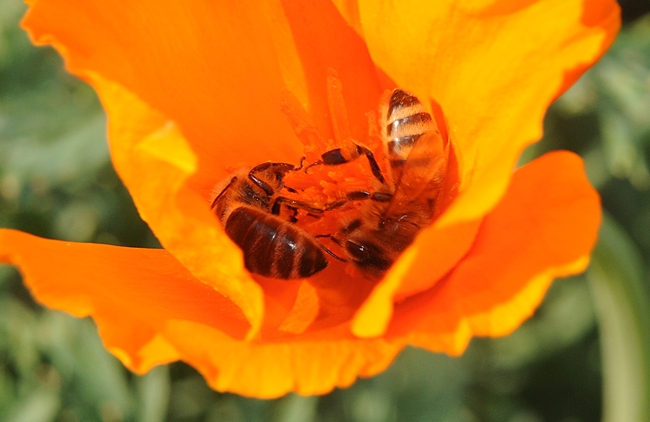
Two honey bees sharing a California poppy on Garrod Drive, UC Davis. (Photo by Kathy Keatley Garvey)
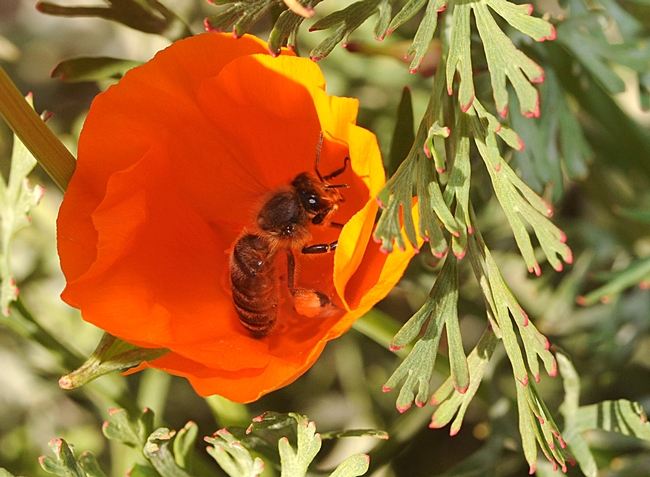
Honey bee foraging in a California poppy. The green leaves are tinged with red, holiday colors. (Photo by Kathy Keatley Garvey)
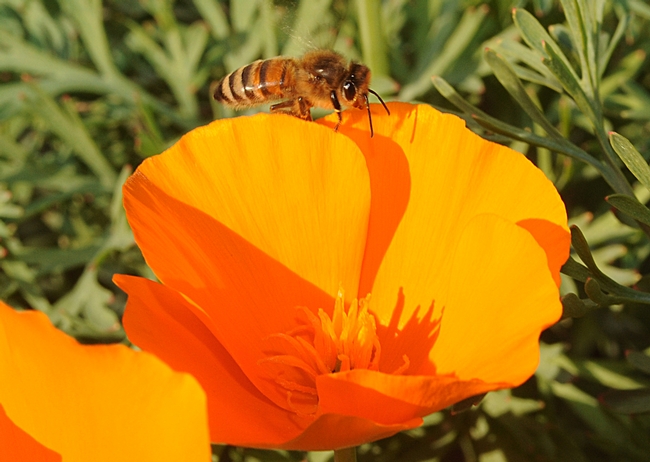
Honey bee walking along a petal of a California poppy. (Photo by Kathy Keatley Garvey)
Heirloom Seeds
Happy New Year 2012 to everyone! The parties are over, the leftovers are gone, and the weather is a little gray. What is a gardener to do? Well, there are some very wonderful seed catalogs available to spark your imagination and help you plan for a new year. They may even offer you the opportunity to plan for a spring or summer vacation centered on gardening events.
Two new catalogs for me both offer heirloom and open-pollinated seeds. An open-pollinated (OP) variety is one that breeds true from seed, meaning the seed saved from the parent plant will grow offspring with the same characteristics. OP seed is produced by allowing the natural flow of pollen between different plants of the same variety. Heirloom varieties are OP varieties with a long history of being cultivated and saved within a family or group. They have evolved by natural or human selection over time.
A hybrid variety, on the other hand, does not breed true from seed. Hybrid seed is produced by crossing two different parent varieties of the same species. Hybrids do not remain true in generations after the initial cross and cannot be saved from generation to generation unchanged. So if you like to save seeds from your favorite flowers or super sweet tomatoes, this is good to know.
As I was looking through the beautiful pictures in Seed Savers Exchange and Baker Creek Heirloom Seeds, I noticed that Crane melons were in each catalog. These melons bring back memories of my childhood in Sonoma County. The melons were introduced in the 1920’s by Oliver Crane whose family farmed six generations near Santa Rosa, California. The melon is a pear-shaped Crenshaw-type fruit that grows 3-5 pounds. The yellow green skin is covered in dark freckles and is ready for picking when the freckles turn orange. The light orange flesh has a great sweet flavor and takes 75-85 days to produce. Perhaps they will ripen even faster under Solano sun.
To get copies of the Seed Savers Exchange catalog from Decorah, Iowa go to www.seedsavers.org. The Baker Creek Heirloom Seeds can be found at www.rareseeds.com. Although Baker Creek is based out of Mansfield, Missouri, there is a seed store in Petaluma, called the Seed Bank, originally the first Bank of America building in town. Both catalogs have calendars of garden events for 2012 and even some free webinars that don’t require travel.


